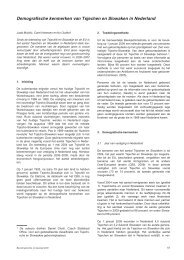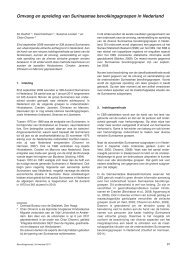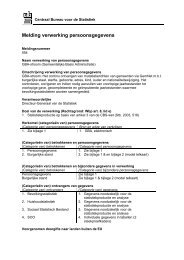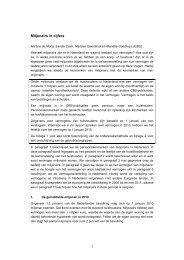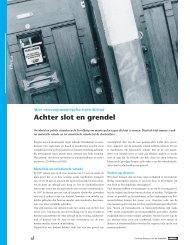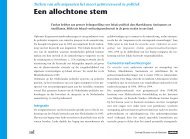Babyboomers in the Netherlands: What the statistics say - Cbs
Babyboomers in the Netherlands: What the statistics say - Cbs
Babyboomers in the Netherlands: What the statistics say - Cbs
Create successful ePaper yourself
Turn your PDF publications into a flip-book with our unique Google optimized e-Paper software.
terms. From this start<strong>in</strong>g po<strong>in</strong>t, <strong>the</strong>y were able to move<br />
up <strong>the</strong> hous<strong>in</strong>g ladder <strong>in</strong> <strong>the</strong> course of time to ever<br />
better and larger homes. Two out of three baby boom<br />
households owned <strong>the</strong>ir home <strong>in</strong> 2009.<br />
Civilised city<br />
The baby boom generation grew up <strong>in</strong> what Harry<br />
L<strong>in</strong>tsen, professor <strong>in</strong> history of technology, called ‘<strong>the</strong><br />
civilised city’ (1950–1970). Interest <strong>in</strong> personal hygiene<br />
and bath<strong>in</strong>g <strong>in</strong>creased, <strong>the</strong> sanitary <strong>in</strong>frastructure was<br />
completed: public bathhouses disappeared and were<br />
replaced by showers <strong>in</strong> <strong>the</strong> home.<br />
Ideas about hous<strong>in</strong>g quality, residential civilisation and<br />
amenities <strong>in</strong> <strong>the</strong> home changed only slowly, though. In<br />
1914, Amsterdam’s health committee was still of <strong>the</strong><br />
op<strong>in</strong>ion that a simple dwell<strong>in</strong>g should have a liv<strong>in</strong>g<br />
room, a kitchen, enough bedrooms so that bro<strong>the</strong>rs<br />
and sisters did not have to share, a toilet and a<br />
washhouse. In 1932 <strong>the</strong> committee reported that a<br />
bath<strong>in</strong>g or shower facility was required for new<br />
dwell<strong>in</strong>gs if <strong>the</strong>re was no public bathhouse <strong>in</strong> <strong>the</strong><br />
neighbourhood.<br />
Only <strong>in</strong> 1951 did a shower room become <strong>the</strong> norm <strong>in</strong><br />
social hous<strong>in</strong>g. Stricter requirements for dwell<strong>in</strong>gs<br />
<strong>in</strong>troduced <strong>in</strong> 1965 led to better equipped homes. The<br />
number of homes with a bath rose from 6 percent <strong>in</strong><br />
1965 to 43 percent <strong>in</strong> 1977.<br />
largest cities. In <strong>the</strong> four ma<strong>in</strong> cities, Amsterdam,<br />
Rotterdam, The Hague and Utrecht, but also <strong>in</strong><br />
Gron<strong>in</strong>gen, E<strong>in</strong>dhoven, Almere and Tilburg, <strong>the</strong><br />
percentages of 55–64 year-olds are 11 or lower. In o<strong>the</strong>r<br />
municipalities with more than 100 thousand<br />
<strong>in</strong>habitants <strong>the</strong> percentage of baby-boomers is only<br />
above average (13.2 percent) <strong>in</strong> Zoetermeer, Emmen,<br />
Apeldoorn and Maastricht. In <strong>the</strong> municipality of<br />
Blaricum, baby boomers account for more than 20<br />
percent of <strong>the</strong> population.<br />
Where baby boomers live, 2011<br />
Less than 12%<br />
12 to 14%<br />
14 to 16%<br />
16% or more<br />
Baby boomers avoid largest cities<br />
There is no specific pattern <strong>in</strong> <strong>the</strong> location of baby<br />
boomers; <strong>the</strong>y now live across <strong>the</strong> country. One<br />
noticeable aspect is that that relatively few live <strong>in</strong> <strong>the</strong><br />
Baby boomers 23




